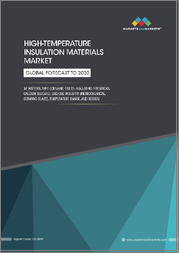
|
시장보고서
상품코드
1605289
혼합 섬유 시장 규모, 점유율, 성장 분석 : 원료별, 제품별, 용도별, 지역별 - 산업 예측(2024-2031년)Blended Fibers Market Size, Share, Growth Analysis, By Source (Synthetic, Natural), By Product (Cotton/Polyester, Cotton/Polyester/Cellulose), By Applications (Apparel, Home Furnishing), By Region - Industry Forecast 2024-2031 |
||||||
혼합 섬유 세계 시장 규모는 2022년에 406억 달러를 기록했으며, 2023년 432억 달러에서 2031년에는 715억 달러로 성장하고, 예측기간(2024-2031년) 동안 CAGR은 6.5%로 성장할 전망입니다.
세계 혼합 섬유 시장은 혼방 직물에 대한 수요 증가, 가처분 소득 증가, 소비자 선호도 변화, 섬유 혼방 기술의 발전 등으로 인해 주목할 만한 성장을 보이고 있습니다. 지속가능성과 친환경에 대한 인식이 높아짐에 따라 혼합 섬유는 기존 직물을 대체할 수 있는 친환경 직물로 더욱 매력적으로 다가오고 있습니다. 경쟁 환경은 주요 업체들이 지속적인 제품 혁신과 전략적 제휴를 통해 경쟁하고 있는 것이 특징입니다. 아시아태평양, 특히 중국과 인도와 같은 섬유 제조 강국이 큰 시장 점유율을 차지하고 있습니다. 이러한 성장의 원동력은 탄탄한 섬유 부문, 소득 증가, 패션 트렌드의 변화입니다. 또한, 지속가능한 실천을 향한 추진력과 섬유 혼합의 혁신은 새로운 시장 기회를 창출하고 있습니다. 원자재 가격 변동과 섬유 생산에 대한 엄격한 화학제품 규제에도 불구하고, 우수한 섬유 블렌딩을 위한 연구개발이 성장을 촉진할 것으로 예상됩니다. 결국, 세계 혼합 섬유 시장은 향후 몇 년 동안 고기능성 섬유에 대한 수요가 증가하고 신흥 시장에서 최종 이용 산업이 확대됨에 따라 크게 성장할 준비가 되어 있습니다.
목차
소개
- 조사 목적
- 조사 범위
- 정의
조사 방법
- 정보 조달
- 2차 데이터와 1차 데이터 방법
- 시장 규모 예측
- 시장 가정과 제한
주요 요약
- 세계 시장 전망
- 공급과 수요 동향 분석
- 부문별 기회 분석
시장 역학과 전망
- 시장 개요
- 시장 규모
- 시장 역학
- 성장 촉진요인과 기회
- 성장 억제요인과 과제
- Porters 분석과 영향
- 경쟁 기업 간의 경쟁 관계
- 대체품의 위협
- 구매자의 교섭력
- 신규 참여업체의 위협
- 공급 기업의 교섭력
주요 시장 인사이트
- 핵심성공요인
- 경쟁 정도
- 주요 투자 기회
- 시장 생태계
- 시장 매력 지수(2023년)
- PESTEL 분석
- 거시경제 지표
- 밸류체인 분석
- 가격 분석
- 기술의 진보
- 규제 상황
- 사례 연구
혼합 섬유 시장 규모 : 원료별 & CAGR(2024-2031)
- 시장 개요
- 합성
- 천연
혼합 섬유 시장 규모 : 제품별 & CAGR(2024-2031)
- 시장 개요
- 코튼/폴리에스테르
- 코튼/폴리에스테르/셀룰로오스
- 나일론/울
- 에러 스탠/나일론/코튼
혼합 섬유 시장 규모 : 용도별 & CAGR(2024-2031)
- 시장 개요
- 의류
- 홈퍼니싱
- 테크니컬
혼합 섬유 시장 규모 : 지역별 & CAGR(2024-2031)
- 북미
- 미국
- 캐나다
- 유럽
- 영국
- 독일
- 스페인
- 프랑스
- 이탈리아
- 기타 유럽
- 아시아태평양
- 중국
- 인도
- 일본
- 한국
- 기타 아시아태평양
- 라틴아메리카
- 브라질
- 기타 라틴아메리카
- 중동 및 아프리카
- GCC 국가
- 남아프리카공화국
- 기타 중동 및 아프리카
경쟁 정보
- 상위 5개사의 비교
- 주요 기업의 시장 포지셔닝(2023년)
- 주요 시장 기업이 채용한 전략
- 시장의 최근 동향
- 기업의 시장 점유율 분석(2023년)
- 주요 기업 개요
- 기업 개요
- 제품 포트폴리오 분석
- 부문별 점유율 분석
- 매출 전년비 비교(2021-2023)
주요 기업 개요
- Reliance Industries Limited(India)
- Welspun India Limited(India)
- Sutlej Textiles and Industries Limited(India)
- Hebei Diamond Cashmere Products(China)
- Pennine Textile and Recycling(UK)
- James Robinson Fibers(USA)
- National Spinning Company(USA)
- Kanti Fashion(India)
- Natural Fiber Welding Inc.(USA)
- Toray Industries, Inc.(Japan)
- Aditya Birla Group-Birla Cellulose(India)
- Teijin Limited(Japan)
- Marzotto Group(Italy)
- Grasim Industries(India)
- Indorama Ventures Public Company Limited(Thailand)
- Dralon GmbH(Germany)
- Texhong Textiles(China)
- Luthai Textile(China)
- Formosa Taffeta Co., Ltd.(Taiwan)
결론과 추천사항
ksm 24.12.16Global Blended Fibers Market size was valued at USD 40.6 Billion in 2022 and is poised to grow from USD 43.2 Billion in 2023 to USD 71.5 Billion by 2031, growing at a CAGR of 6.5% during the forecast period (2024-2031).
The global blended fibers market is experiencing noteworthy growth, driven by rising demand for blended fabric, an increase in disposable incomes, evolving consumer preferences, and advancements in fiber blending technologies. Heightened awareness of sustainability and eco-friendliness is further enhancing the appeal of blended fibers as a greener alternative to traditional fabrics. The competitive landscape is marked by major players engaging in continuous product innovation and strategic collaborations. The Asia-Pacific region, particularly with textile manufacturing powerhouses like China and India, commands a significant market share. This growth is bolstered by a robust textile sector, rising incomes, and shifting fashion trends. Additionally, the push towards sustainable practices and innovations in fiber blends are set to unlock new market opportunities. Research and development efforts aimed at creating superior fiber blends are expected to drive further growth, despite challenges such as raw material price volatility and stringent chemical regulations in fiber production. Ultimately, as demand for high-performance textiles rises and end-use industries expand in emerging markets, the global blended fibers market is well-positioned for substantial growth in the forthcoming years.
Top-down and bottom-up approaches were used to estimate and validate the size of the Global Blended Fibers market and to estimate the size of various other dependent submarkets. The research methodology used to estimate the market size includes the following details: The key players in the market were identified through secondary research, and their market shares in the respective regions were determined through primary and secondary research. This entire procedure includes the study of the annual and financial reports of the top market players and extensive interviews for key insights from industry leaders such as CEOs, VPs, directors, and marketing executives. All percentage shares split, and breakdowns were determined using secondary sources and verified through Primary sources. All possible parameters that affect the markets covered in this research study have been accounted for, viewed in extensive detail, verified through primary research, and analyzed to get the final quantitative and qualitative data.
Global Blended Fibers Market Segmental Analysis
Global Blended Fibers Market is segmented by Source, Product, Application and region. Based on Source, the market is segmented into Synthetic, Natural. Based on Product, the market is segmented into Cotton/Polyester, Cotton/Polyester/Cellulose, Nylon/Wool, Elastane/Nylon/Cotton. Based on application, the market is segmented into Apparel, Home Furnishing, Technical. Based on region, the market is segmented into North America, Europe, Asia Pacific, Latin America and Middle East & and Africa.
Driver of the Global Blended Fibers Market
A significant driver of the global blended fibers market is the rising demand for sustainable and eco-friendly products. As consumers gain awareness of the environmental ramifications of their purchasing decisions, they increasingly favor blended fibers that present a more sustainable option compared to traditional fabrics. These blended materials, particularly those that integrate natural fibers, play a vital role in minimizing carbon emissions and fostering a more environmentally responsible textile sector. This shift towards sustainability is shaping market trends, encouraging manufacturers to innovate and prioritize eco-friendly practices that align with consumer preferences for greener alternatives.
Restraints in the Global Blended Fibers Market
One significant challenge facing the Global Blended Fibers market is the volatility in raw material prices. The costs associated with both synthetic and natural fibers can vary widely due to numerous factors, including shifts in supply and demand, geopolitical tensions, and alterations in production expenses. Such fluctuations create obstacles for manufacturers, making it difficult to manage costs effectively and potentially diminishing the profitability of blended fiber products. Consequently, stakeholders in the market must remain vigilant and responsive to these price changes to lessen their impact and ensure financial stability within the industry.
Market Trends of the Global Blended Fibers Market
The Global Blended Fibers market is witnessing a significant trend towards sustainability, fueled by consumer demand for eco-friendly and ethically produced textiles. This shift prioritizes natural fibers and recycled materials, fostering innovation in blended fiber compositions that enhance performance while minimizing environmental impact. Manufacturers are increasingly adopting sustainable practices and transparency in their supply chains, aligning with the broader movement towards responsible consumption in the textile sector. Consequently, this trend not only addresses consumer preferences but also catalyzes industry-wide transformations, positioning the blended fibers market as a pivotal player in the transition towards greener alternatives in fashion and textiles.
Table of Contents
Introduction
- Objectives of the Study
- Scope of the Report
- Definitions
Research Methodology
- Information Procurement
- Secondary & Primary Data Methods
- Market Size Estimation
- Market Assumptions & Limitations
Executive Summary
- Global Market Outlook
- Supply & Demand Trend Analysis
- Segmental Opportunity Analysis
Market Dynamics & Outlook
- Market Overview
- Market Size
- Market Dynamics
- Driver & Opportunities
- Restraints & Challenges
- Porters Analysis & Impact
- Competitive rivalry
- Threat of substitute
- Bargaining power of buyers
- Threat of new entrants
- Bargaining power of suppliers
Key Market Insights
- Key Success Factors
- Degree of Competition
- Top Investment Pockets
- Market Ecosystem
- Market Attractiveness Index, 2023
- PESTEL Analysis
- Macro-Economic Indicators
- Value Chain Analysis
- Pricing Analysis
- Technological Advancement
- Regulatory Landscape
- Case Studies
Global Blended Fibers Market Size by Source & CAGR (2024-2031)
- Market Overview
- Synthetic
- Natural
Global Blended Fibers Market Size by Product & CAGR (2024-2031)
- Market Overview
- Cotton/Polyester
- Cotton/Polyester/Cellulose
- Nylon/Wool
- Elastane/Nylon/Cotton
Global Blended Fibers Market Size by Application & CAGR (2024-2031)
- Market Overview
- Apparel
- Home Furnishing
- Technical
Global Blended Fibers Market Size & CAGR (2024-2031)
- North America, (Source, Product, Application)
- US
- Canada
- Europe, (Source, Product, Application)
- UK
- Germany
- Spain
- France
- Italy
- Rest of Europe
- Asia-Pacific, (Source, Product, Application)
- China
- India
- Japan
- South Korea
- Rest of Asia Pacific
- Latin America, (Source, Product, Application)
- Brazil
- Rest of Latin America
- Middle East & Africa, (Source, Product, Application)
- GCC Countries
- South Africa
- Rest of Middle East & Africa
Competitive Intelligence
- Top 5 Player Comparison
- Market Positioning of Key Players, 2023
- Strategies Adopted by Key Market Players
- Recent Developments in the Market
- Company Market Share Analysis, 2023
- Company Profiles of All Key Players
- Company Details
- Product Portfolio Analysis
- Company's Segmental Share Analysis
- Revenue Y-O-Y Comparison (2021-2023)
Key Company Profiles
- Reliance Industries Limited (India)
- Company Overview
- Business Segment Overview
- Financial Updates
- Key Developments
- Welspun India Limited (India)
- Company Overview
- Business Segment Overview
- Financial Updates
- Key Developments
- Sutlej Textiles and Industries Limited (India)
- Company Overview
- Business Segment Overview
- Financial Updates
- Key Developments
- Hebei Diamond Cashmere Products (China)
- Company Overview
- Business Segment Overview
- Financial Updates
- Key Developments
- Pennine Textile and Recycling (UK)
- Company Overview
- Business Segment Overview
- Financial Updates
- Key Developments
- James Robinson Fibers (USA)
- Company Overview
- Business Segment Overview
- Financial Updates
- Key Developments
- National Spinning Company (USA)
- Company Overview
- Business Segment Overview
- Financial Updates
- Key Developments
- Kanti Fashion (India)
- Company Overview
- Business Segment Overview
- Financial Updates
- Key Developments
- Natural Fiber Welding Inc. (USA)
- Company Overview
- Business Segment Overview
- Financial Updates
- Key Developments
- Toray Industries, Inc. (Japan)
- Company Overview
- Business Segment Overview
- Financial Updates
- Key Developments
- Aditya Birla Group - Birla Cellulose (India)
- Company Overview
- Business Segment Overview
- Financial Updates
- Key Developments
- Teijin Limited (Japan)
- Company Overview
- Business Segment Overview
- Financial Updates
- Key Developments
- Marzotto Group (Italy)
- Company Overview
- Business Segment Overview
- Financial Updates
- Key Developments
- Grasim Industries (India)
- Company Overview
- Business Segment Overview
- Financial Updates
- Key Developments
- Indorama Ventures Public Company Limited (Thailand)
- Company Overview
- Business Segment Overview
- Financial Updates
- Key Developments
- Dralon GmbH (Germany)
- Company Overview
- Business Segment Overview
- Financial Updates
- Key Developments
- Texhong Textiles (China)
- Company Overview
- Business Segment Overview
- Financial Updates
- Key Developments
- Luthai Textile (China)
- Company Overview
- Business Segment Overview
- Financial Updates
- Key Developments
- Formosa Taffeta Co., Ltd. (Taiwan)
- Company Overview
- Business Segment Overview
- Financial Updates
- Key Developments



















